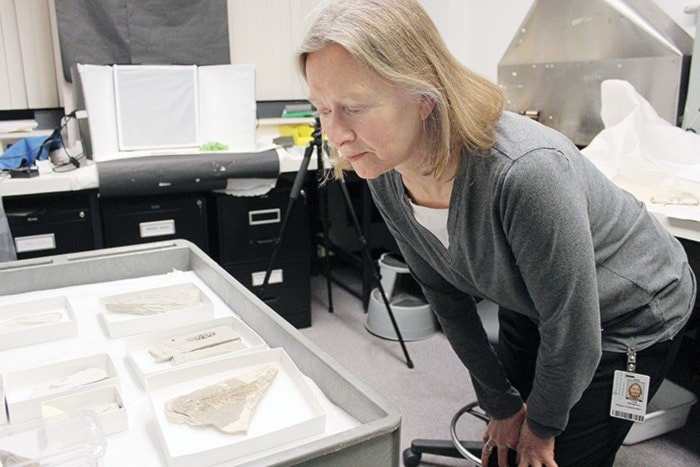Sitting in a dimly-lit gallery space, surrounded by people watching her every move, Lisa Bengston meticulously works on one of the oldest Chinese lanterns in Canada.
She is working on a Chinese Freemason revolving horse lantern as part of a conservation project with the Royal B.C. Museum's Tradition in Felicities: Celebrating 155 years of Victoria's Chinatown exhibit in 2013.
The roughly four-foot-tall lantern was created in Victoria in the 1930s by a Chinese master from Hong Kong and is the oldest known surviving lantern of its kind in Canada's Chinatowns.
The traditional arts and crafts lantern operates by the rising heat from two light bulbs in the base where the movement of warm air causes the fan and wheel at the top to rotate.
The horsemen appear to be gliding.
Crabs' pinchers move back and forth and deers' heads tilt up and down.
When it came to the museum in 2012, the lantern was dirty, dusty and extremely fragile. Its bamboo frame was broken, papers were torn and missing and the plastic film was disintegrating.
Bengston's job as an objects conservator with the museum was to stabilize the object and stop the materials from deteriorating further.
Over the next nine months, alongside a team of five conservators and volunteers, Bengston went to work cleaning the surface with a vaccuum and dry erasers to remove dirt, mending the broken bamboo frame and tears in paper, and removing some of the panels and flattening them — all in front of the public.
“I was privileged to have been able to work on a project like that because that only comes once in your career,” Bengston said. “It meant so much to people. People had ties to it and I felt humbled to be able to hear their stories and also be able to stabilize it so that it lasts a long time from now.”
This was the longest conservation treatment of a single artifact in which Bengston has participated. It also earned her the Keck Award from the International Institute for Conservation of Historic and Artistic Works in 2014 for promoting public understanding and appreciation of conservation.
When she's not working on months-long projects, Bengston is one of two objects conservators at the Royal B.C. Museum, working with objects made of metal, feathers, fur, bone and plastics.
Bengston first came to the museum as a textile conservation intern in 1989. and acquired a permanent position at the museum in 1991. She also completed her masters degree at Queens University in Kingston, specializing in objects.
On a daily basis, Bengston is responsible mainly for preventive conservation — work to prevent future damage to artifacts. She makes sure objects are displayed, stored, packed and transported in optimal environments to prevent damage to the artifacts, by monitoring the relative humidity, temperature and light levels.
Bengston is also responsible for inspecting almost any object that comes into the museum to ensure there are no insects such as carpet beetles and clothes moths that could damage artifacts.
Most artifacts on display in the museum don't require specialized micro environments. But there are artifacts on loan from other museums that require environmental monitoring, such as mummies and animals in a sarcophagus during the Egypt exhibit in 2004 where they had to keep the environment dry.
Bengston has worked on a number of high-profile objects such as an Oscar, an Emmy, Grammys, Olympic medals, a Nobel prize medal and gold coins and nuggets as part of the museum’s Gold Rush! Exhibit. As part of her job, she has travelled to Turkey, Greece, and Jordan as a conservator on archaeological digs as well.
“I always liked working on things and fixing things as a kid,” she said. “I like working with objects, I like doing hands-on treatments where something needs to be stabilized. I like testing objects, sometimes it's like detective work to figure out what will be appropriate. You can use this shell but you can't use this shell.”
